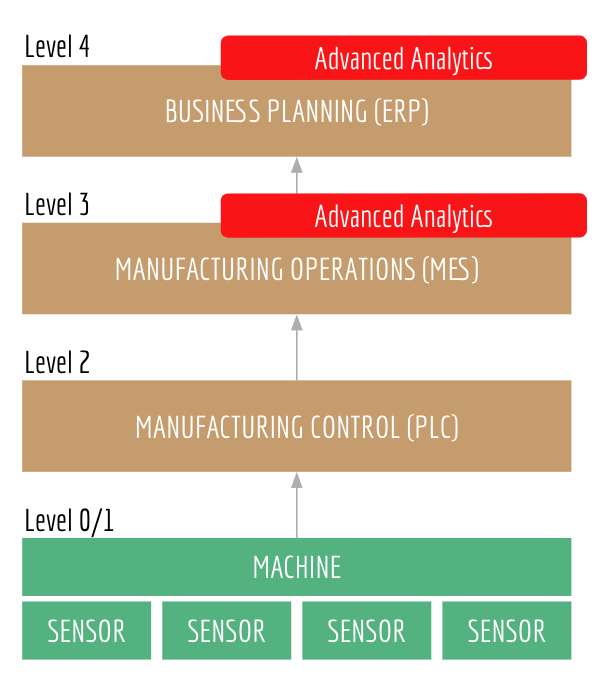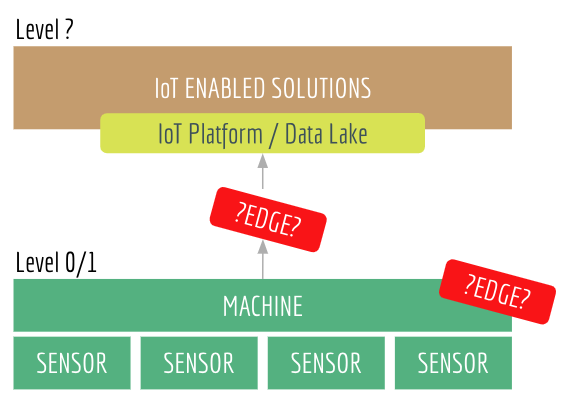Last week I wrote/ranted about the current (missing) level of Device (Machine) Lifecycle Management in IoT Platforms. This week I am sharing another aspect of late musings in my chaotic grey matter. I would like to talk about the definition, or better, the lack of consensus around EDGE Computing & EDGE Analytics in the realm of I(I)oT.
Introduction to The Cloud
About ten years ago now I was quite active as an implementation consultant in physical to virtual migrations and the emergence of the “private cloud”. We spent many years before that and even after that, defining what “the cloud” was. Everybody had their own definition as usual but we ended up today having more or less an agreement on the fact that private, public, hybrid, or shared cloud environments are physical location and that cloud computing is more or less a logical concept.
On Industrial Analytics
In the manufacturing industry, there’s the ISA 95 standard that defines 4 levels (actually 5 with level 0) of intelligence, ranging from the physical machine and sensors, all the way up to the business processes. They actually are pretty well aligned also with their physical location (machine > line/unit > site > enterprise).
In the past decade, we’ve been adding some advanced Analytics technologies especially on top of layer 3 (operations & execution) and level 4 (business).

We need MOOOOORE data
Being in the age of “data is the new oil“* , we found that the information we got from our equipment became insufficient. This is where we see the first Edge Analytics cases pop up. We see both equipment manufacturers adding more sensors and intelligence into their newer models, we see smart meters being added on top of existing equipment, and we’ve seen existing automation players adding more analytics capabilities in the Level 2 Control layer.

The question now is, which one is rightfully called EDGE analytics? Does it have to be in/on the machine to be edge? Is the production line still ok? Some will even go as far as calling any new service they are running on-premises an edge computing case. Others will call that ‘fog’ computing (as in, not as high as the cloud … #sic). This is why we’re in the exact same debate as we were 10 years ago when it was about cloud.
* data is not really the new oil, it’s ‘information’ but I didn’t want to be pedantic on my own writing
And now, we mix
And now let’s make it even more complicated! What if there is just NOTHING between your machine and the business logic? If you look at IoT, you’ll notice that the majority of smarter equipment is just no longer connected through such a 4-level data infrastructure.

IoT devices today are smart-phones, connected cars, but also industrial equipment in the field, or track & trace tags on assets. All of them with their own challenges. Do we now make the calculations inside the device itself or do we need to add an edge computing computer locally before the calculated results are uploaded to the IoT Platform/Data Lake?
The Edge computing challenges
The main thing about EDGE Computing/Analytics is that they solve different needs. I’ll summarize the most top of mind one right here.
Network Bandwidth & Data Storage
Saving network bandwidth is usually the number #1 argument everyone understands. Adding millions and millions of sensors from hundreds of thousands of devices in a very high frequency is both costly to send the data over any network, but also costly to store. There are not a lot of time series databases out there that are really well built yet for this. And if they are … $$$.
So the more data you can save by doing calculations before transferring the data, or not even sending it at all will greatly save on architectural complexity and overall connectivity costs.
Power
This one makes a great difference between all versions of IoT solutions. Whether or not you have access to (sufficient) power will drive the hardware designs and will restrict your capabilities. The sensors usually don’t use the most power. It’s both the calculations on top of those sensors and the type of network you are using.
Regular cell-phone networks (3G/4G/5G) are just NOT going to help here since they all use way too much power. That’s the whole reason people invented LP-WANs, or Low Power Wide Area Networks. Sigfox, LoRaWAN, NB-IoT, UWB, … all of them serve a specific purpose like covering very long distances or private versus public. But none of them are a one ring to rule them all. And the downside of all of them is that the frequency of data is quite limited! So pick your battles wisely!
Let’s say you want to monitor a shipping container. If you want to do anything more than just track and trace, you’ll need a lot more power to do that. But shipping containers usually are not powered by themselves so you’ll need to power your monitoring device for both the calculations and the data connectivity. Oh … and you’ll probably not be able to charge this on on your night stand …
Closed Loop Control
Do you know PID (proportional integral derivative) control loops? It’s basically a closed system that will regulate itself through a predefined algorithm under changing conditions. Think about keeping the temperature of your living room stable. If you want 70F (21C) in your home, your system will have to take into account delays, oscillation, … of the variables in order to know when to turn the heater on or off. The better this calculation is performed, the more stable the outcome.
Now think about doing more complex things than just regulating temperature. What if I wanted to use a CCTV camera in combination with AI to identify whether or not everyone on a construction site is wearing the appropriate hard hats and gloves? If you want to set off an immediate alert through flashlights or sirens, you will have to make sure this is a closed-loop system that does not require data to be sent over a network to a centralized computing platform.
Now apply this thinking to autonomous vehicles and you’ll understand why we want these systems to be intelligent but independent (aka EDGE). Luckily that car does have a battery to power these calculations 😉
Summary
EDGE Computing and Analytics is not even close to all fall into one single category. Therefore it is imperative that you really know which problem you want to solve and what you are ready to give up for it! Lots of data + High Frequency Rate + Complex Calculations + Closed Loop + Low Power really really is fighting the laws of physics …
